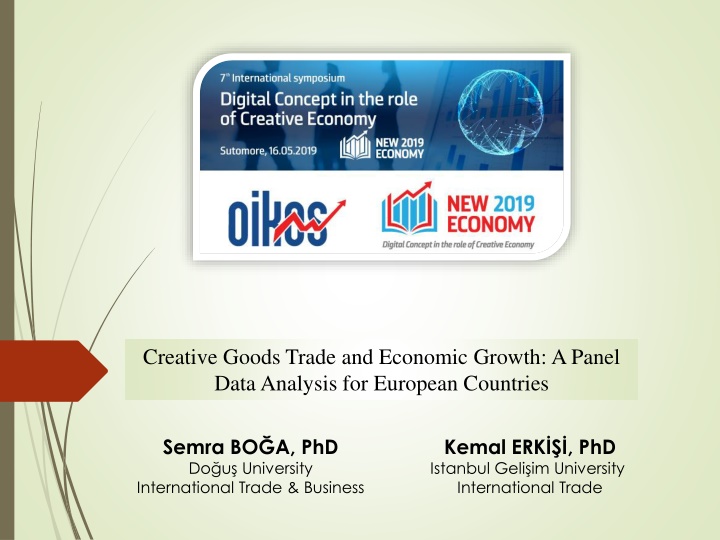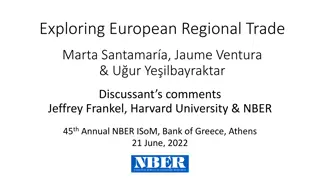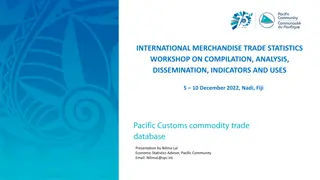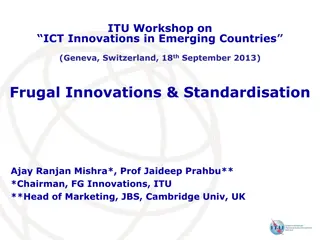
Creative Goods Trade and Economic Growth in European Countries Panel Data Analysis
The study explores the relationship between GDP and creative goods trade in European countries from 2002 to 2015 through panel data analysis. With a focus on the importance of the creative sector for economic growth, the research aims to provide evidence for policy-making in the cultural and creative industries. The empirical analysis includes 35 European countries, examining the expansion of the global market for creative goods and the significance of this sector for GDP and employment. Statistical methods such as functional, statistical, VAR models, and Granger panel causality analysis will be employed to investigate short-term and long-term relationships between variables.
Download Presentation

Please find below an Image/Link to download the presentation.
The content on the website is provided AS IS for your information and personal use only. It may not be sold, licensed, or shared on other websites without obtaining consent from the author. If you encounter any issues during the download, it is possible that the publisher has removed the file from their server.
You are allowed to download the files provided on this website for personal or commercial use, subject to the condition that they are used lawfully. All files are the property of their respective owners.
The content on the website is provided AS IS for your information and personal use only. It may not be sold, licensed, or shared on other websites without obtaining consent from the author.
E N D
Presentation Transcript
Creative Goods Trade and Economic Growth: A Panel Data Analysis for European Countries Semra BO A, PhD Do u University International Trade & Business Kemal ERK , PhD Istanbul Geli im University International Trade
Introduction With its potential to create both commercial and cultural value, the creative sector is regarded as a important source of economic growth. It accounts for approx. 3% of world GDP. The creative sector for Europe represents 6.8 % of European GDP (approximately 860 billion) and 6.5% of European employment (approximately 14 million) (Benzoni, L.,& Hardouin, P., 2014) The size of the global market for creative goods has expanded substantially more than doubling in size from $208 billion in 2002 to $509 billion in 2015 (UNCTAD, 2018) Global trade in creative goods is expanding with average export growth rates of more than 7% (UNCTAD, 2019).
The Purpose and the Motivation of the Study In order to help cultural and creative sectors with evidence-based policy-making, the European Commission and Eurostat are working on cultural statistics and other relevant studies. The purpose of this study is to highlight the importance of creative goods trade by revealing the relationship between GDP and creative goods trade. The lack of empirical studies in this specific field constitutes the main motivation of this study.
Empirical Analysis Countries of Analysis and Time Period Countries included The Dataset covers Austria Belgium Bulgaria Croatia Cyprus Czech Rep Denmark Estonia Finland France Germany Greece Hungary Iceland Ireland Luxembourg Macedonia 490 annual GDP and CREATIVE GOODS TRADE of 35 European between 2002-2015. observations composed of Malta countries Montenegro Netherlands Norway Poland Portugal Romania Serbia Slovakia Slovenia Data set was compiled from the web base statistical sources of EUROSTAT. Creative goods include art crafts, audiovisuals, design, performing arts, arts. new media, viusal publishing, Spain Sweden Switzerland Turkey Italy Latvia UK Lithuania
Method Primarily the (a) functional, (b) statistical and (c) VAR models will be established, and the significance of the variables and the model will be investigated. The following tests are used to evaluate the appropriate analytic approach; a) cross-sectional dependency, b) stationarity, c) homogeneity will be evaluated. Then, Dumitrescu & Hurlin (2012) Granger Panel Causality Analysis will be conducted to evaluate short-term causality. WesterlundECM Panel Co-integration Test and the PMG Estimator will be employed to examine if there is a long-term relationship between the variables.
Statistical Model (1) ?????= ? + ?1???????+ ??? GDP TRADE : Import + Exports of Creative Goods (current US$), : Gross Domestic Product (constant 2010 US$) VAR Model (2) (3)
Significance of the Variables and the Model: Pooled Least Square Results (4) ???????= ? + ?1?????????+ ???
Cross-Sectional DependenceAnalysis Pesaran (2004) CD Test Results H0 : there is no correlation between the units. REJECTED This result will be considered in selection of the right Stationary, Panel Causality and Co-integration Method
Stationarity Analysis Im-Pesaran-Shin unit-root test LEVEL I(0) FIRST DIFFERENCE-I(1) t-bar Stat. p-value -4.4443 -15.7822 Series GDP TRADE t-bar Stat. 0.4138 -1.3377 p-value 0.6605 0.0905 0.0000* 0.0000* Note : * indicates stationary at 1% significance level Ho: All panels contain unit roots Ha: Some panels are stationary The results indicate that all the series are stationary at first difference level : the integration order of the series are I(1)
Stationarity Analysis Fisher-PP unit-root test for TRADE LEVEL I(0) Stat. 79.7388 0.7947 0.6293 0.8231 FIRST DIFF. -I(1) t-bar Stat. 240.7036 -9.0525 -10.2816 14.4271 p-value 0.1995 0.7866 0.7350 0.2052 p-value 0.0000* 0.0000* 0.0000* 0.0000* Inverse chi-squared(70) P Inverse normal Inverse logit t(179) Modified inv. chi-squared Pm Z L* Note : * indicates stationary at 1% significance level for GDP LEVEL I(0) Stat. 71.4455 -0.1436 -0.1286 0.1222 FIRST DIFF. -I(1) Stat. 138.8765 -4.3812 -4.7229 5.8211 p-value 0.4295 0.4429 0.4489 0.4514 p-value 0.0000* 0.0000* 0.0000* 0.0000* Inverse chi-squared(70) P Inverse normal Inverse logit t(179) Modified inv. chi-squared Pm Z L* The results indicate that all the series are stationary at first difference level : the integration order of the series are I(1)
Homogeneity Test: Swamy S Test of parameter constancy Prob>chi2 Chi2 0.0000* 306.93 ???????= ? + ?1??????? 1+ ?2?????????+ ??? 0.0000* 480.41 ?????????= ? + ?3????????? 1+ ?4???????+ ??? The H0 hypothesis parameters are homogenous is rejected, and it is decided that the parameters are heterogeneous. Dumitrescu and Hurlin (2012) Granger Panel Causality Test, which considers the heterogeneity, will be employed.
Lag-Length: Hansen J Test J lag CD J MBIC MAIC MQIC p-value .0028519 -43.02102* .0096212 .4957908 .4654447 1 2 3 4 .9999922 .9999919 .9999945 .9999941 36.04526 26.33491 7.384321 3.582505 4.045259 2.334911 -15.08107 -12.00983 -32.9648 -32.14882 -8.615679* -18.17884* -16.18407 -4.417495 -9.199077 Because of the values of the lag-length which performed the minimum of the selection criteria of MAIC and MQIC are 3, the appropriate lag- length is selected as 3.
VAR Panel Causality Short-Term Analysis Dumitrescu & Hurlin (2012) Granger Panel Causality Test Results H0: Hypothsis W-bar Stat. Z-bar tilde (p-value) 5.1132 3.1996 (0.0014)* TRADE does not Granger-cause GDP GDP does not Granger-cause TRADE Note : * indicates stationary at 1% significance level 2.8190 4.2873 (0.0000)* Variable Relationships Variable ECONOMIC GROWTH (GDP) TRADE
Long-term Analysis: Westerlund ECM Panel Co-integration Test The robust p-values which are considered for heterogeneous panel cointegration, are greater than 5%. Therefore, the H0 hypothesis is accepted and It was concluded that there is no co-integration, so no long-term relationship between GDPand TRADE established.
Results As a result, in the short-term; We found a bi-directional causal relationship between International Trade of Creative Goods and Economic Growth. With this perspective International trade of Creative goods supports Economic Growth and Economic Growth supports the creative goods trade. a) 1% increase in TRADE causes a 0.057 % increase in GDP, vice versa; b) -ec coefficient shows that 29% of the imbalances in a period, because of a shock, can be recovered in the next period. However, we did not find a long-term relationship between these variables.
Limitations Availability of the data for relatively short time period (13 years) Measurement problems with the existing data due to definition differences: broad or narrow definitions. The inter-sectoral and diffuse nature of the creative economy makes it difficult to establish appropriate indicators.
Conclusion & Further Research As the findings of the research reveals there exists a bidirectional granger causal relationship between GDP and Creative Goods Trade in the short-term. However, creative goods trade does not contribute to the potential growth rate of the countries in the long-term. Further research needed with the inclusion of other variables such as technological products and human capital in order to better assess the long-run relationship.
Thank you Creative Goods Trade and Economic Growth: A Panel Data Analysis for EU Countries






















